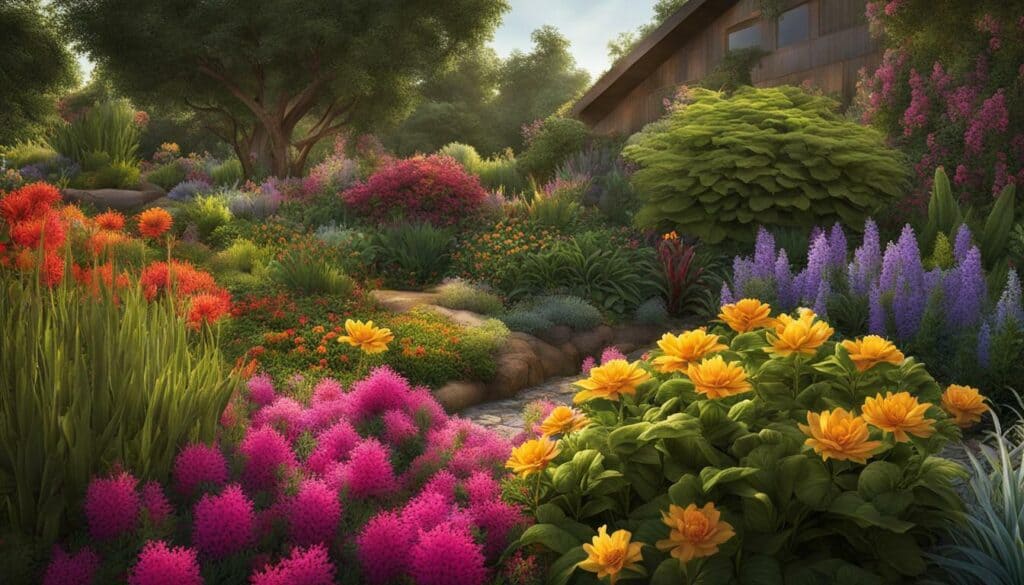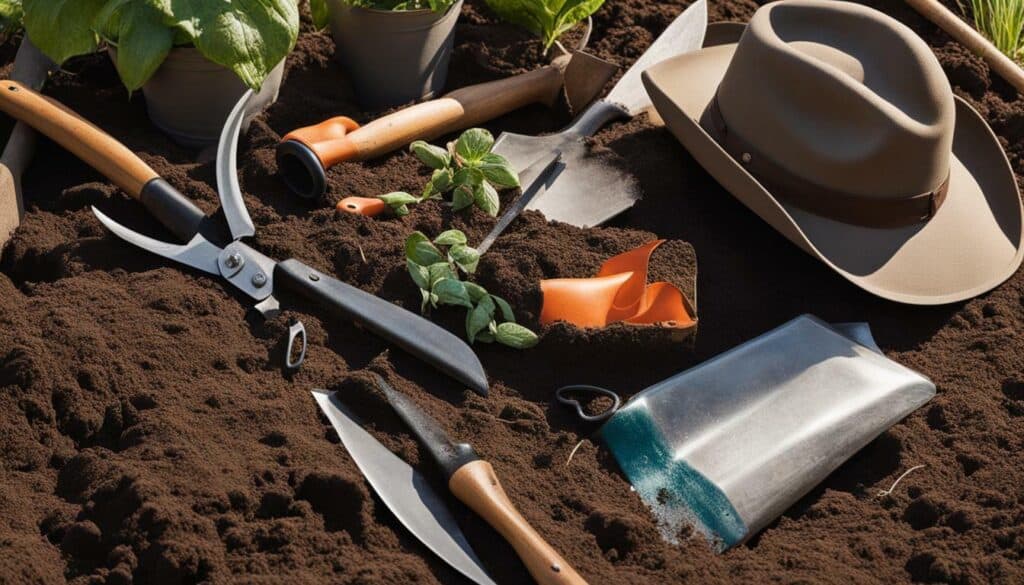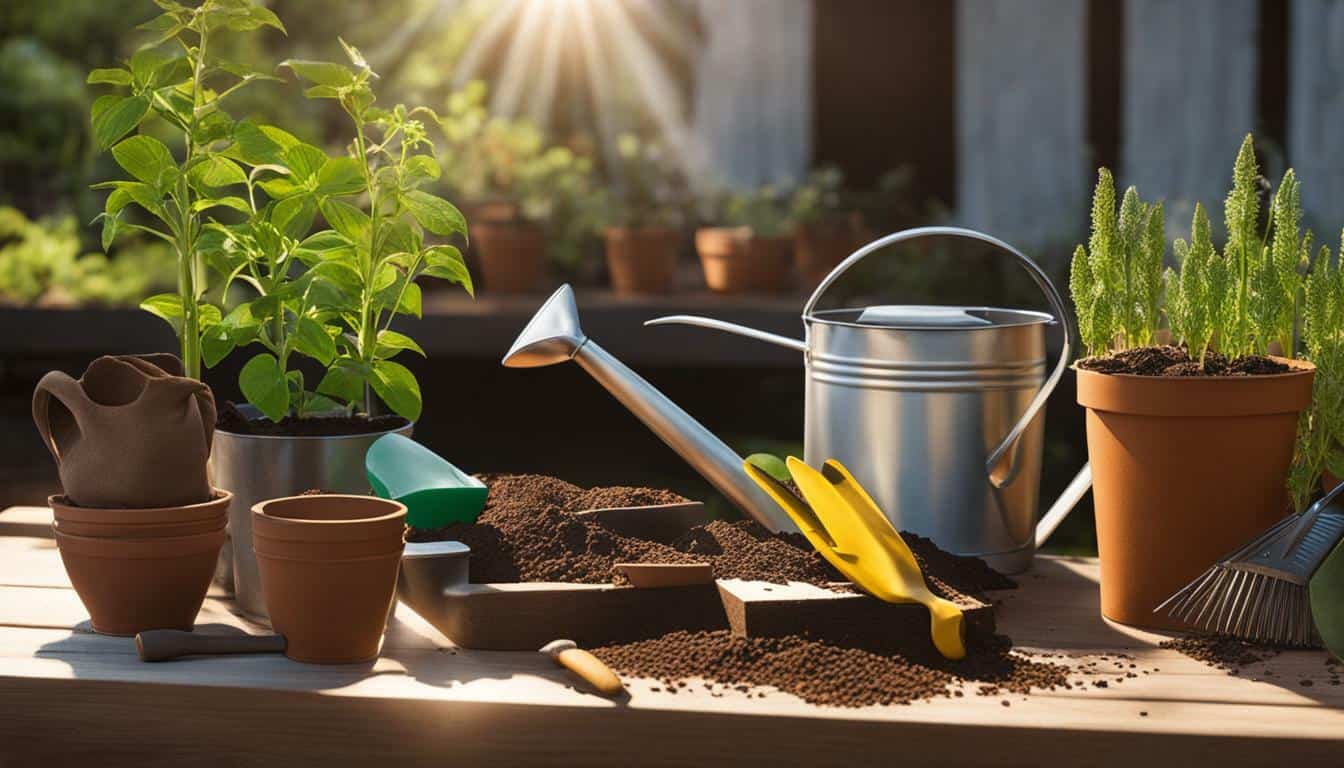Are you ready to cultivate your green thumb and start your own garden? Here’s everything you need to know to get started.
If you’re looking to start gardening, there are a few key things you need to know. First, choose a sunny spot with well-drained soil for your garden. It’s also important to start small, especially if you’re a beginner, and only grow what you know you and your family will eat. Consider the availability of vegetables at your grocery store and be realistic about how many vegetables your family will actually consume. It’s also crucial to plant each vegetable at the right time, based on your specific region and growing zone.
Additionally, make sure you have the necessary tools and supplies for gardening, such as a trowel, shovel, pruning shears, and watering can. Finally, don’t get discouraged if you face challenges or setbacks along the way. With persistence and patience, you’ll be rewarded with a beautiful and bountiful garden.
Key Takeaways:
- Choose a sunny spot with well-drained soil for your garden
- Start small and grow what you and your family will eat
- Consider the availability of vegetables at your grocery store
- Plant each vegetable at the right time based on your region and growing zone
- Ensure you have the necessary tools and supplies for gardening
Choosing the Right Location for Your Garden
The success of your garden starts with choosing the perfect location. Make sure to find a sunny spot with well-drained soil to provide the ideal conditions for your plants. Sunlight is essential for plant growth and productivity, so aim for an area that receives at least 6-8 hours of direct sunlight per day. This will ensure that your plants photosynthesize effectively and produce an abundance of flowers and fruits.
When it comes to soil, well-drained soil is crucial. It allows excess water to drain away, preventing root rot and other water-related issues. Soil that is compacted or retains too much moisture can hinder plant growth and lead to disease. Before planting, test your soil’s drainage by digging a hole and filling it with water. If the water takes more than a few hours to drain, you may need to amend the soil with organic matter to improve drainage.
Creating a raised bed or using containers can also be a great solution if your natural soil is not ideal. This way, you have better control over the soil quality and can ensure proper drainage. Plus, raised beds and containers offer the added benefit of reducing weed growth and making it easier to tend to your plants.

Creating a Garden in Limited Space
If you have limited space, don’t worry! You can still enjoy the benefits of gardening by utilizing creative solutions. Vertical gardening, for example, allows you to grow plants upwards, maximizing space. You can use trellises, wall-mounted planters, or hanging baskets to grow climbing vegetables like tomatoes or beans.
“Gardening is a great way to connect with nature and reap the rewards of your hard work.”
Another option is to incorporate container gardening. Containers can be placed on patios, balconies, or even windowsills, providing a convenient way to grow herbs, small vegetables, and flowers. Just remember to choose containers with proper drainage holes and use a high-quality potting mix.
- Choose a sunny spot with at least 6-8 hours of direct sunlight per day.
- Ensure the soil is well-drained to prevent water-related issues.
- Consider raised beds or containers if your natural soil is not suitable.
- Explore vertical gardening or container gardening for limited space.
| Pros of Choosing a Sunny Spot | Cons of Choosing a Sunny Spot |
|---|---|
| Optimal plant growth and productivity | Potential for sunburn and heat stress on plants |
| Increased flower and fruit production | Higher risk of water evaporation, requiring more frequent watering |
| Improved photosynthesis and nutrient absorption | Possible nutrient leaching due to excessive rain or irrigation |
Starting Small: Beginner’s Guide to Plant Selection
As a beginner, it’s best to start small and focus on growing vegetables that you and your family enjoy. Consider what’s readily available at your local grocery store and choose plants that you are familiar with to set realistic expectations.
By starting small, you can gain confidence and experience as a gardener without overwhelming yourself. Begin with a few easy-to-grow varieties, such as tomatoes, lettuce, or herbs. These plants tend to be resilient and forgiving for beginners.
One helpful tip is to grow what you already know. If you enjoy cooking with certain herbs or using specific vegetables in your favorite recipes, consider starting with those. It will be exciting to grow your own ingredients and have them readily available in your backyard.
Remember, the goal is to enjoy the process and learn along the way. Embrace the joy of nurturing plants and watching them flourish. Gardening can be a rewarding and therapeutic hobby, but it’s important to start with achievable goals. It’s better to have a small, thriving garden than an overwhelming one that becomes a source of stress.
Tips for Successful Plant Selection:
- Choose plants that are suitable for your climate and growing conditions.
- Consider the space you have available in your garden – some plants require more room to spread out.
- Research the specific needs of each plant, including sunlight, water, and soil requirements.
- Experiment with different varieties to discover your personal favorites.
Starting small doesn’t mean you can’t expand your garden in the future. As you gain experience and confidence, you can gradually add more plants and experiment with new varieties. The key is to enjoy the process and have fun exploring the world of gardening.
| Plant | Why Choose It |
|---|---|
| Tomato | Easy to grow, versatile, and produces abundant fruit. |
| Lettuce | Quick-growing and perfect for fresh salads. |
| Basil | Aromatic herb that adds flavor to many dishes. |
Starting small and selecting the right plants for your garden will set you on the path to a successful and enjoyable gardening journey. Remember, every plant you grow is a step toward creating a beautiful and bountiful garden that brings you and your family joy.
Timing Matters: Planting for Your Region and Zone
To maximize your chances of success, it’s crucial to plant each vegetable at the right time, taking into account the specific conditions of your region and growing zone. When it comes to gardening, timing is everything. Planting too early or too late can result in poor growth and yield.
Each plant has its own ideal planting window, which is influenced by factors such as temperature, frost dates, and daylight hours. By understanding your region’s climate and growing zone, you can determine the best time to start planting.
Use the table below to find your growing zone and corresponding planting dates:
| Growing Zone | Planting Dates |
|---|---|
| Zone 1 | May – June |
| Zone 2 | April – May |
| Zone 3 | April – May |
| Zone 4 | March – April |
| Zone 5 | March – April |
| Zone 6 | March – April |
Remember, these dates are just a general guideline. It’s always a good idea to consult a local gardening expert or extension office for more specific recommendations based on your region and microclimate.
By aligning your planting schedule with your growing zone, you’ll give your plants the best chance to thrive. This not only increases the likelihood of a successful harvest but also helps you avoid wasting time and resources on plants that may not survive in your climate.

Essential Tools and Supplies for Gardening
Equipping yourself with the right tools and supplies is essential for a smooth gardening experience. Make sure you have a sturdy trowel, shovel, pruning shears, and a watering can to get started. These tools will help you dig and prepare the soil, trim and shape your plants, and provide them with the water they need to thrive.
One of the most important tools for any gardener is a trowel. This handheld tool is perfect for digging small holes for seeds or transplants, as well as loosening soil and removing weeds. Look for a trowel with a comfortable handle and a sturdy metal blade that can withstand repeated use.
A shovel is another must-have tool for gardening. It’s ideal for digging larger holes for planting shrubs or trees, as well as moving soil and compost. Choose a shovel with a sturdy handle and a sharp blade that can easily penetrate the ground.
Pruning shears are essential for maintaining the health and shape of your plants. Use them to trim off dead or damaged branches, shape shrubs, and prune flowering plants. Look for a pair of shears with a sharp blade and comfortable handles that fit well in your hand.
| Essential Gardening Tools | Why You Need Them |
|---|---|
| Trowel | For digging, planting, and weeding |
| Shovel | For digging large holes and moving soil |
| Pruning shears | For trimming, shaping, and pruning plants |
| Watering can | For providing water to your plants |
Lastly, a watering can is essential for hydrating your plants. It allows for precise watering and prevents overwatering, which can be detrimental to plants. Look for a watering can with a comfortable handle and a removable spout for easy filling.
Equipped with these essential tools, you’ll be well-prepared to embark on your gardening journey. Remember, investing in quality tools will save you time and effort in the long run. Soon enough, you’ll be enjoying the fruits of your labor as your garden flourishes.

Overcoming Challenges and Setbacks
Gardening can present its fair share of challenges, but don’t let them discourage you. Remember to stay persistent and patient as you navigate through any setbacks you may encounter. It’s important to understand that not everything will go according to plan when it comes to gardening, but that’s part of the journey.
One of the common challenges gardeners face is dealing with pests and diseases. It can be disheartening to see your plants being attacked or becoming sick, but there are ways to overcome these issues. Identifying the problem early on is key, as it allows you to take timely action. Whether it’s using organic pest control methods or implementing disease-resistant varieties, there are various ways to protect your garden from these threats.
Another challenge that may arise is weather-related setbacks. Extreme temperatures, unexpected frosts, or heavy rains can have a detrimental effect on your plants. However, with proper planning and preparation, you can minimize the impact. Consider using protective coverings like row covers or cloches to shield your plants from harsh weather conditions. Additionally, planting a diverse range of crops and utilizing companion planting techniques can help increase resilience to fluctuating conditions.
Lastly, don’t forget about the importance of soil health. Poor soil quality can hinder plant growth and lead to disappointing results. Take the time to amend your soil with organic matter, such as compost or aged manure, to improve its structure and fertility. Testing your soil’s pH and nutrient levels can also provide valuable insights for optimal plant growth. Remember, building healthy soil is a long-term investment that pays off in the long run.

| Common Gardening Challenges | Ways to Overcome Them |
|---|---|
| Pests and Diseases | – Regularly inspect plants and take immediate action if pests or diseases are detected. – Use organic pest control methods and disease-resistant varieties. – Practice good garden hygiene and remove any infected plants or debris. |
| Weather-related Setbacks | – Monitor weather forecasts and be prepared to protect plants from extreme temperatures, frost, or heavy rains. – Use protective coverings like row covers or cloches. – Plant a diverse range of crops and utilize companion planting techniques for increased resilience. |
| Soil Quality | – Improve soil health by adding organic matter such as compost or aged manure. – Test soil pH and nutrient levels to ensure optimal plant growth. – Practice crop rotation to prevent nutrient depletion and soil-borne diseases. |
Remember, gardening is a process of learning and adaptation. Embrace the challenges and setbacks as opportunities for growth and improvement. Stay persistent, be patient, and enjoy the journey towards creating a beautiful and bountiful garden.
Enjoying the Fruits of Your Labor
Your efforts will not go in vain when you witness the beauty and abundance of your thriving garden. Sit back, relax, and savor the fruits of your labor. As you admire the vibrant colors and lush greenery that surround you, take a moment to reflect on the journey that led to this bountiful harvest.
Imagine plucking plump, juicy tomatoes straight from the vine, or enjoying a crisp salad with lettuce and cucumbers picked just moments ago. The satisfaction of knowing that you grew these delectable treats with your own hands is truly unmatched. Every bite is a testament to your dedication and hard work.
Not only is a garden visually pleasing, but it also provides a sense of tranquility and peace. The rhythmic sound of birds chirping and the gentle rustle of leaves in the breeze create a soothing atmosphere that can help relieve stress and promote overall well-being. Your garden becomes a sanctuary, a place where you can escape from the demands of daily life and reconnect with nature.
| Benefits of Enjoying a Beautiful and Bountiful Garden: |
|---|
| 1. Fresh and flavorful produce. |
| 2. Sense of accomplishment. |
| 3. Connection with nature. |
| 4. Stress relief. |
| 5. Sanctuary for relaxation. |
So, as you sit in your garden oasis, take a moment to fully appreciate the beauty and abundance that surrounds you. It’s a testament to your hard work, patience, and love for gardening. Let the satisfaction of a successful harvest fill your heart, and let the flavors of your homegrown produce nourish your body and soul.

Quote:
“A garden brings life and joy to your surroundings. It is a canvas where you can paint your dreams and watch them bloom.” – Unknown
Tips and Tricks for a Flourishing Garden
Curious about how to take your garden to the next level? Check out these helpful tips and tricks that will contribute to the overall health and success of your plants.
1. Watering Wisely: While it’s important to keep your plants hydrated, it’s equally important to water them correctly. Avoid overwatering, as this can lead to root rot and other plant diseases. Instead, water deeply and less frequently to encourage strong root growth. Using a soaker hose or drip irrigation system can help deliver water directly to the root zone, minimizing water waste and promoting healthier plants.
2. Fertilizing Effectively: A well-balanced fertilizer can provide the essential nutrients your plants need for optimal growth. Consider using organic fertilizers, which are derived from natural sources and promote long-term soil health. Be mindful of the fertilizer’s NPK ratio (nitrogen, phosphorus, potassium), as different plants have varying nutrient requirements. Apply fertilizer according to the package instructions, and remember that more is not always better – over-fertilization can harm your plants.
3. Preventing Pests: Dealing with pests can be a frustrating part of gardening, but there are steps you can take to minimize their impact. Encourage beneficial insects, such as ladybugs and lacewings, by planting flowers that attract them. Additionally, practicing good garden hygiene, like removing dead leaves and debris, can help reduce pest populations. If necessary, use organic pest control methods to protect your plants without harming the environment.
4. Pruning for Success: Regular pruning helps maintain the shape, size, and overall health of your plants. Remove dead or damaged branches to prevent the spread of diseases and promote better air circulation. Prune flowering plants after they bloom to encourage new growth. Remember to use clean and sharp pruning shears to minimize the risk of infection.

By following these tips and tricks, you’ll be well on your way to creating a flourishing garden that brings you joy and satisfaction. Remember, gardening is a journey of continuous learning, so don’t be afraid to experiment and adapt your approach based on your plants’ specific needs. Happy gardening!
Connecting with Other Gardeners
Gardening is not only a solitary endeavor but also a wonderful opportunity to connect with fellow enthusiasts. Explore local gardening groups or online communities to find a network of like-minded individuals who can offer support and inspiration. Being part of a gardening community allows you to share your experiences, learn from others, and exchange tips and tricks for a flourishing garden.
One way to connect with other gardeners is by joining a local gardening club or organization. These groups often hold regular meetings, workshops, and events where you can meet experienced gardeners and beginners alike. They may also have community gardens or shared spaces where you can work alongside others, fostering a sense of camaraderie and collaboration.
Another option is to explore online gardening forums and social media groups. These platforms provide a convenient way to connect with gardeners from all over the world, share photos and stories, and seek advice on specific gardening challenges. You can ask questions, share your successes, and find inspiration from the accomplishments of others.
By connecting with other gardeners, you not only expand your knowledge and skills but also build meaningful relationships with individuals who share your passion. The gardening community is a supportive and inclusive one, always ready to celebrate your achievements and offer guidance during difficult times. So, don’t hesitate to reach out, connect, and become part of this vibrant network of garden enthusiasts.
Congratulations! You now know everything you need to start gardening and embark on an exciting and rewarding journey.
If you’re looking to start gardening, there are a few key things you need to know. First, choose a sunny spot with well-drained soil for your garden. Having ample sunlight and good drainage is essential for the healthy growth of your plants.
It’s also important to start small, especially if you’re a beginner. Only grow what you know you and your family will eat. Consider the availability of vegetables at your grocery store and be realistic about how many vegetables your family will actually consume. By starting small and focusing on what you enjoy, you’ll have a better chance of success.
Another crucial factor in gardening is timing. Make sure to plant each vegetable at the right time, based on your specific region and growing zone. This will ensure that your plants have the best chance of thriving and producing a bountiful harvest.
Of course, having the necessary tools and supplies is also important. A trowel, shovel, pruning shears, and watering can are some of the essential tools you’ll need for gardening. These will help you with tasks such as planting, digging, pruning, and watering.
Lastly, don’t get discouraged if you face challenges or setbacks along the way. Gardening is a journey that requires persistence and patience. With time and effort, your garden will flourish beautifully, and you’ll be rewarded with the satisfaction of growing your own food and enjoying the beauty of nature.
What Are the Must-Have Items for Starting a Vibrant Garden?
Creating a vibrant garden requires a few essential garden elements. First, quality soil enriched with compost provides a nourishing foundation for plant growth. Secondly, garden tools such as a shovel, rake, and pruners are necessary for cultivation and maintenance. Additionally, a variety of seeds and plants, chosen based on your climate and preference, are vital for a diverse and vibrant garden. Lastly, proper watering equipment, like a hose or watering can, ensures plants receive sufficient hydration.
FAQ
Q: What are the key things I need to start gardening?
A: To start gardening, you’ll need a sunny spot with well-drained soil, the necessary tools and supplies (such as a trowel, shovel, pruning shears, and watering can), and a selection of plants or seeds.
Q: How do I choose the right location for my garden?
A: It’s important to choose a sunny spot with well-drained soil for your garden. Look for an area that receives at least six hours of sunlight per day and ensure that the soil drains well to prevent waterlogged roots.
Q: Should I start small if I’m a beginner gardener?
A: Yes, starting small is recommended for beginners. Only grow what you know you and your family will eat. Consider the availability of vegetables at your grocery store and be realistic about how many vegetables your family will actually consume.
Q: When should I plant each vegetable?
A: Planting time for each vegetable varies depending on your specific region and growing zone. Research the recommended planting times for your area to ensure optimal growth and harvest.
Q: What are the essential tools and supplies for gardening?
A: Essential tools and supplies for gardening include a trowel, shovel, pruning shears, and watering can. These tools will help you with tasks such as planting, digging, pruning, and watering your plants.
Q: What should I do if I face challenges or setbacks in my garden?
A: Don’t get discouraged if you face challenges or setbacks along the way. Gardening is a learning process, and it’s normal to encounter obstacles. Stay persistent, be patient, and seek advice from experienced gardeners or gardening communities for support and guidance.
Q: How can I enjoy the fruits of my garden’s labor?
A: After putting in the effort to create and maintain your garden, you can enjoy the fruits of your labor by harvesting and consuming the fresh produce you’ve grown. There’s nothing quite like the satisfaction of eating food you’ve nurtured from seed to plate.
Q: Do you have any tips for a flourishing garden?
A: To ensure a flourishing garden, make sure to water your plants consistently, provide them with adequate nutrients through fertilization, and protect them from pests and diseases. Regularly monitor your plants’ growth and address any issues promptly.
Q: How can I connect with other gardeners?
A: Connecting with other gardeners can provide valuable support, advice, and inspiration. Look for local gardening clubs or online communities where you can share your experiences, ask questions, and learn from others.





Leave a Reply